INPS is promoting the use of native plants in landscaping instead of invasive plants through the Grow Indiana Natives program.
An estimated 86{7cd3ab6da66055a2172268ce683e542bdb5f3094ce8844f56308c5fd128d2605} of invasive woody species, species like Asian Bush Honeysuckle, Privet, and Burning Bush, come from landscape plantings. This program rewards businesses who sell native plants by providing marketing materials that highlight the native plants they sell.
If businesses agree to stop selling invasive plants, they become Invasive-Free Members of Grow Indiana Natives and are featured in the Buy Natives directory. Look for these logos when choosing where to shop for plants.
Have more questions about the Grow Indiana Natives program? Find answers on our FAQ page.
What’s an Invasive Plant?
An invasive plant is a non-native plant that infests natural areas and causes environmental or economic harm, or harm to human health. Of the roughly 2,900 plant species growing outside of cultivation in Indiana, approximately 33{7cd3ab6da66055a2172268ce683e542bdb5f3094ce8844f56308c5fd128d2605} are non-native but only a small fraction of those non-native species are invasive. Invasive plants degrade and destroy thousands of acres of our natural plant communities in Indiana. Each year millions of dollars are spent to control them.
Why Care About Invasives?
- Invasive plants cost money. A 2012 survey of 120 agencies and landowners in Indiana found we spent $5.7million to manage these species and protect our natural areas. Nationally, agricultural and control costs due to invasive plants are estimated at $15 billion per year. Each year the cost grows.
- Invasive plants hurt wildlife by crowding out the plants our native animals need for food and cover.
- Most invasive shrubs and trees are little used by native insects. This reduces habitat for beneficial pollinators and predatory insects, as well as reducing the amount of food available for birds to feed their nestlings.
- Invasive plants destroy habitat for rare wildflowers and animals, threatening two-thirds of all endangered species.
- Invasive plants can become weedy in a home garden, crowding out other landscaping.
- Invasive plants can also decrease your ability to enjoy hunting, fishing, mushroom collecting, bird-watching, and many other recreational pursuits by crowding forest floors and choking waterways, making use of these areas difficult.

Purple loosestrife






